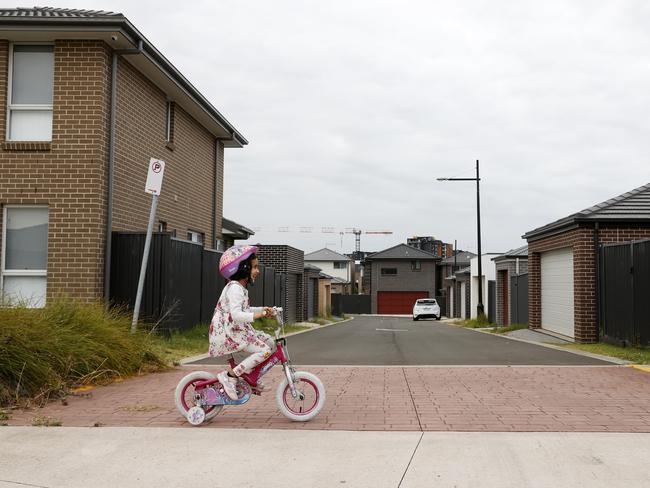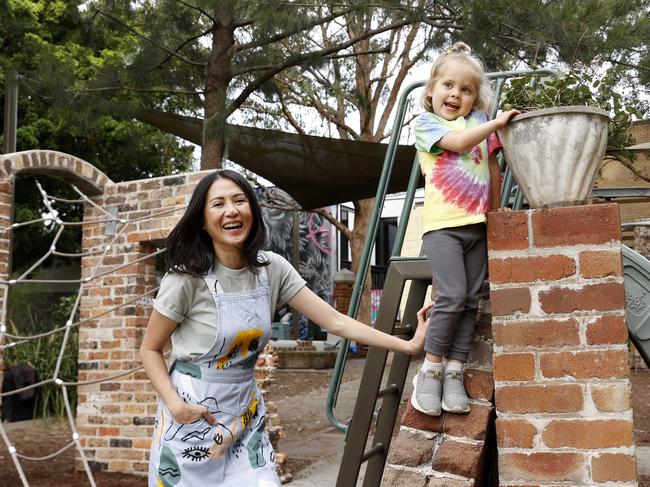Dominic Perrottet’s warning that Bradfield city can’t be like Zetland
Stunning artist’s impressions of Sydney’s upcoming new western city have been revealed, as Dominic Perrottet warns there’s only “one chance” to get the design right.
NSW
Don't miss out on the headlines from NSW. Followed categories will be added to My News.
The city of Bradfield rising from the ground around Western Sydney Airport presents an once-in-a-lifetime opportunity – but it’s crucial the mistakes of the past aren’t repeated in with the new metropolis, Premier Dominic Perrottet has warned.
The Daily Telegraph can also reveal exclusive new images of what Bradfield and the aerotropolis surrounding the new airport will look like within two decades – with the metropolis including 11,400 new homes and more than 100,000 new jobs to be a leafy, hi-tech oasis.
Mr Perrottet told The Telegraph Bradfield and the aerotropolis couldn’t repeat the mistakes of the south Sydney suburb of Zetland – which after a massive urban renewal project resulted in street upon street of featureless apartment blocks in a new-build wasteland.
“I don’t want us repeating the planning and architectural mistakes of the past. There are parts of Zetland for example, where if planners and architects had their time again, I reckon they would have done things differently,” Mr Perrottet told The Telegraph.
“It is a suburb whose best feature is that it eventually ends.”

Mr Perrottet has previously said of Zetland that it was “like something’s arrived from another planet and landed” and questioned: “How do you think (it) is going to look in thirty years’ time?”
He said there was “one chance” to get Bradfield right.
“We need to plan, design and build a Bradfield City Centre that will be appeal to people for generations to come,” he said.
“We have one chance to get Bradfield right. I want to make sure that in 50 years’ time, Bradfield is still an appealing place to live and work but is also still appealing on the eye.”

The comments come at a crucial juncture for the city, which in 2023 will start wholesale construction when the master plan for it is released.
Critical infrastructure will rumble ahead underground with construction on the pipes and pits that will bring mass renewable energy, super speed internet and recycled water into the city so it’s business ready.
Work will also begin on the roads that will bring people to the Bradfield city centre, alongside the metro which will open in 2026 and connect the west with a high-speed, driverless transport all the way to the Sydney CBD.
While plans abound to make the city centre a hi-tech business hub, greenery is key to its success in Sydney’s west.

Leafy surroundings – key to driving down urban heat – will be underpinned by a park 1.8 hectares in size, which is set to be located next to the entry for the Metro near the town’s centre.
Getting those key parts of infrastructure in place before the first homes are built is key to avoiding the mistakes of the past according to Jennifer Westacott, the chair of the Western Parkland City Authority tasked with co-ordinating the building of the new city.
“This is a city that’s going to be done differently. We’re going to drive new industry and jobs and infrastructure first before houses go in,” she said.
“Traditionally it’s been the opposite which has resulted in a lot of unfairness in western Sydney … this is a reverse model of city building.”
I don’t want a treeless home
Months of temperatures soaring above 35C will become the norm for Sydney residents living on the city’s western boundary – with the current “moonscape” approach to development wiping out the iconic image of a home among the gumtrees.
Western Sydney University’s associate professor in urban studies Dr Sebastian Pfautsch said the current housing model for estates in western Sydney was broken, with no space left for trees on the new homes springing up in their thousands on the city’s outskirts.
“Because we’re building such big houses on such small blocks, we have no chance to get trees in the front or back yard,” he said.

While temperatures were set to skyrocket in coming years as global warming and urban heat impacts of treeless suburbs took hold, residents were already suffering, he said.
“It is not only in 40 or 50 years’ time when summer hits and there is heatwaves with many, many weeks above 35 degrees (the impact will be felt),” he said.
“They already suffer now.”
He said there needed to be a wholesale change in how new homes were built on Sydney’s outskirts, rather than the removal of existing trees resulting in “moonscape” blocks of land.
“Tree cover is the cheapest and most effective way to reduce urban heating,” Dr Pfautsch said.
“The big question is where do we find the space? For me it’s very clear we have to get much better at getting trees back into private front and backyards.”
Rediscovering the lost art of climbing and playing
Art doesn’t just belong in a museum, fenced off and untouchable, but instead should be placed all across the city for kids and adults to climb.
Passionate about the benefits of playable sculptures, Sydney University visual arts lecturer Dr Sanne Mestrom’s research “Art / Play / Risk” explores how having “simple but radical” installations could help build confidence and resilience in kids and bring out an adult’s inner sense of wonder and curiosity.
The principle of her work is to install artwork in the urban environment to share political and social ideas with the community.
Play is also an essential part of the study, especially for children living in high density areas where they don’t have open spaces to play in.
Meanwhile, offering children and adults sculptures to climb on without any instructions teaches people to assess risk preparing them for a world where they encounter a number of dangerous situations.

Dr Mestrom also said playable sculptures pushed the creativity of adults and kids alike as there were no instructions on how to use them.
“It’s not just for kids, it’s intergenerational, anyone can climb on these sculptures, it creates a sense of wonder in the city because an adult could at any moment climb over these sculptures too,” she said.
“In the long term it brings confidence and resilience for these kids, they‘re not wrapped up in cotton wool, they’re part of the fibre and fabric in the city.”
St Peters resident Sheeda Chen, 42, is mum to Felix, 3, and both have been played on a sculpture at their local park since the toddler was two.
Some parents had concerns about the possible dangers of the installation but Ms Chen said her son had spent time exploring the sculpture.
“His confidence has improved because he’s constantly exploring different ways to climb,” she said.
“I’m one of the parents that have been squeezing myself through things.”




